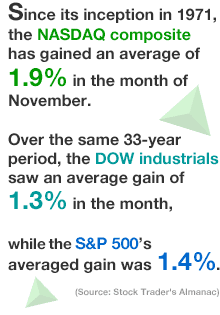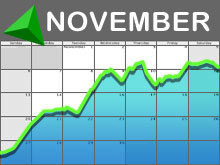 |
 |
| November is usually sweet for stocks. Will that be true this year? |
|
|
|
|
|
|
|
|
|
|
|
NEW YORK (CNN/Money) -
Burned by a tough October? Delirious with dreams of a rally in December?
Hang on: The notoriously wretched October is winding down, November is just around the corner, and if history is a guide, it should be decent.
Barring a stupendous end of month run up, the major gauges are all set to close in the red in October.
Yet October is also a notorious "bear killer," or turnaround month, according to the Stock Trader's Almanac, and it can usher in a better November, and in some years, a pretty strong November through January run.
November is typically the second best month of the year for the S&P 500, according to the Almanac. It is also the third best month of the year for the Dow industrials and Nasdaq. Additionally, there have only been three down Novembers in the last 14 post-presidential election years, like the one we're in now.
Add to that the fact that the major gauges are at or near technical levels that some analysts say would suggest a bounce, and it all looks reasonably good in the short term. Longer term, the story is different.
"The market probably hit a trading bottom last week, and sentiment is negative enough to suggest we'll see a rally," said Steven Goldman, market analyst at research firm Weeden & Co.
"But on the other hand," he added, "the yield on the 10-year is busting out to a more than six-month high, the consumer is taking a financial and psychological hit from the reality of higher heating bills this winter, and we're near the end of third year of a bull market, which tends to be challenging."
Goldman also said that research shows an end-of-year run for the stock market is stronger when the S&P 500 starts this period with year-to-date gains of closer to 10 percent, and is weaker when it is in a range of down 2.5 percent to up around 4 percent.
As of Thursday's close, the S&P 500 is down 1.4 percent for 2005, thanks to a 2.7 percent decline since the start of October.
"Seasonally, we're at the start of what should be the best six months of the year, but I'm cautious," said Jeffrey Hirsch, editor-in-chief of the Almanac. "There's still the potential for November to be OK, but I've tempered our outlook."
Beyond the technical and seasonal factors, here's a look at why else the stock market may rally in November and the headwinds that could stand in the way.
A still strong economy
Two hurricanes, two interest rate hikes and creeping inflation have hurt the economy this fall, but not to the extent that had been feared. "We've seen a resiliency," said Michael Strauss, chief economist at Commonfund.
This resiliency should help stocks gain modestly in the next month or so, Strauss said, augmented by reasonably strong third-quarter earnings, fiscal stimulus and some moderated fears about energy.
Oil prices currently stand at around $60 a barrel, a level that is worrisome, but an improvement from the $70 a barrel level it hit in the aftermath of hurricanes Katrina and Rita, the analysts said.
Yet, oil and gas prices remain high enough to hurt consumer spending and raise the cost of corporations doing business, Strauss said. Worries have escalated lately about corporations needing to pass on those costs to the consumer.
A slowdown in consumer spending would have a pronounced effect on the economy, as the consumer fuels roughly two-thirds of the economy.
"I'm a bit worried about the consumer; that's one area that could be pinched," said Grace Fey, portfolio manager at Frontier Capital Management, noting that the sentiment on the all-important holiday retail sales picture is very negative.
"The recent run up in short-term interest rates is also a risk," she added, alluding to the jump in the 10-year bond yield.
However, she said that despite these headwinds, stocks have been battered significantly enough to see a modest rally through the end of the year.
Inflation and the Fed
Investors are expecting the Federal Reserve to lift short-term interest rates by another 25 basis points at the conclusion of next week's policy setting meeting, leaving the Fed funds rate at 4 percent. There are 100 basis points in a percentage point.
In fact, according to Fed funds futures, traders think it's more than likely that rates will rise by another 25 basis points at the December and January meetings too.
"Over the past month or so Fed governors have been quite hawkish in their language," Goldman said. "I think they've pretty much prepared the market for continued rising rates."
A bigger question for the market might be the new leadership of the Federal Reserve, said Ken Tower, chief, chief market strategist at CyberTrader.
On Monday, President Bush tapped White House advisor and former Fed governor Ben Bernanke to replace current Fed chairman Alan Greenspan, whose term ends January 31. Bernanke was the front runner for the job, and has credentials that Wall Street is generally comfortable with, the analysts said.
"Just knowing who the new Fed chair is going to be is good for the market," Fey said.
However, how comfortable investors are with him remains to be seen, Tower added, noting that the bond market reaction hasn't been encouraging so far. Bond yields jumped for three days following the news of Bernanke's appointment
"There is no person on the planet who is going to be able to fill Greenspan's spot without a test," Tower said. "I'm not sure that it's a coincidence that the market crash of 1987 happened two months after Greenspan took office."
This is one of the reasons Tower is concerned about the market in 2006.
Yet, for the very short term, namely either November or December, Tower thinks it does seem likely that stocks could rise, particularly with a lot of money still on the sidelines.
"I think we have enough pessimism out there that we can see some kind of bounce in November off the October lows," he added. "There will probably be a rally, but it will be conservative."

|